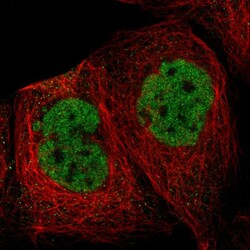Antibody data
- Antibody Data
- Antigen structure
- References [4]
- Comments [0]
- Validations
- Immunocytochemistry [1]
Submit
Validation data
Reference
Comment
Report error
- Product number
- HPA018883 - Provider product page

- Provider
- Atlas Antibodies
- Proper citation
- Atlas Antibodies Cat#HPA018883, RRID:AB_1856763
- Product name
- Anti-SF1
- Antibody type
- Polyclonal
- Description
- Polyclonal Antibody against Human SF1, Gene description: splicing factor 1, Alternative Gene Names: ZCCHC25, ZFM1, ZNF162, Validated applications: ICC, IHC, Uniprot ID: Q15637, Storage: Store at +4°C for short term storage. Long time storage is recommended at -20°C.
- Reactivity
- Human
- Host
- Rabbit
- Conjugate
- Unconjugated
- Isotype
- IgG
- Vial size
- 100 µl
- Concentration
- 0.05 mg/ml
- Storage
- Store at +4°C for short term storage. Long time storage is recommended at -20°C.
- Handling
- The antibody solution should be gently mixed before use.
Submitted references Splicing factor 1 modulates dietary restriction and TORC1 pathway longevity in C. elegans
Molecular and preclinical basis to inhibit PGE 2 receptors EP2 and EP4 as a novel nonsteroidal therapy for endometriosis
The nuclear splicing factor RNA binding motif 5 promotes caspase activation in human neuronal cells, and increases after traumatic brain injury in mice.
Immunofluorescence and fluorescent-protein tagging show high correlation for protein localization in mammalian cells
Heintz C, Doktor T, Lanjuin A, Escoubas C, Zhang Y, Weir H, Dutta S, Silva-García C, Bruun G, Morantte I, Hoxhaj G, Manning B, Andresen B, Mair W
Nature 2016;541(7635):102-106
Nature 2016;541(7635):102-106
Molecular and preclinical basis to inhibit PGE 2 receptors EP2 and EP4 as a novel nonsteroidal therapy for endometriosis
Arosh J, Lee J, Balasubbramanian D, Stanley J, Long C, Meagher M, Osteen K, Bruner-Tran K, Burghardt R, Starzinski-Powitz A, Banu S
Proceedings of the National Academy of Sciences 2015;112(31):9716-9721
Proceedings of the National Academy of Sciences 2015;112(31):9716-9721
The nuclear splicing factor RNA binding motif 5 promotes caspase activation in human neuronal cells, and increases after traumatic brain injury in mice.
Jackson TC, Du L, Janesko-Feldman K, Vagni VA, Dezfulian C, Poloyac SM, Jackson EK, Clark RS, Kochanek PM
Journal of cerebral blood flow and metabolism : official journal of the International Society of Cerebral Blood Flow and Metabolism 2015 Mar 31;35(4):655-66
Journal of cerebral blood flow and metabolism : official journal of the International Society of Cerebral Blood Flow and Metabolism 2015 Mar 31;35(4):655-66
Immunofluorescence and fluorescent-protein tagging show high correlation for protein localization in mammalian cells
Stadler C, Rexhepaj E, Singan V, Murphy R, Pepperkok R, Uhlén M, Simpson J, Lundberg E
Nature Methods 2013;10(4):315-323
Nature Methods 2013;10(4):315-323
No comments: Submit comment
Supportive validation
- Submitted by
- Atlas Antibodies (provider)
- Main image

- Experimental details
- Immunofluorescent staining of human cell line A-431 shows localization to nucleoplasm.
- Sample type
- Human
 Explore
Explore Validate
Validate Learn
Learn Immunocytochemistry
Immunocytochemistry Immunohistochemistry
Immunohistochemistry